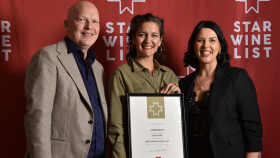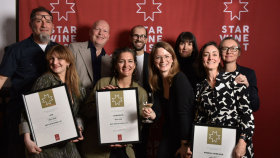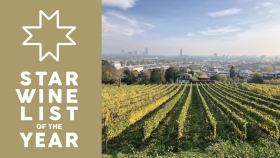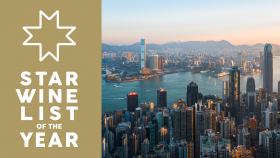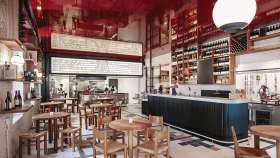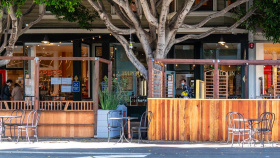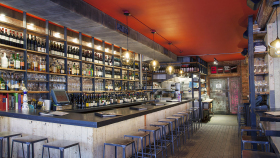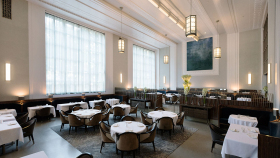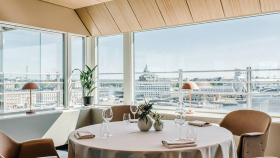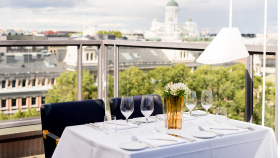New San Francisco ambassador Morgan Harris on the impact of ultra-wealth on the city's dining scene

Star Wine List’s newly appointed ambassador for San Francisco, Morgan Harris MS, stopped by for a quick catch up with Helen Arnold to discuss the city’s dining and drinking trends - and the impact that extreme affluence in parts of the city is having on the hospitality sector.
Seattle-born Morgan Harris is head sommelier at the Michelin-starred Angler Restaurant on the Embarcadero waterfront in San Francisco, part of the Saison Hospitality Group, where he manages a 3,000-strong classically focused wine list with an annual sales volume in excess of $2.5m. He also works as a communicator and educator in the wine space, contributes to a number of drinks publications and has starred in the Amazon TV show Uncorked.

How would you describe the current San Francisco dining landscape?
“Interesting! My perspective, comparing it to New York, [where Harris was head sommelier at Charlie Palmer’s Aureole] that other US capital of fine dining, is that for its size there is a phenomenal concentration of wealth here in San Francisco, being adjacent to the booming tech space in the southern suburbs. The sheer amount of money around means there is a massive amount of discretionary income, and as a result, the number of bars and restaurants catering to that is growing. It is happening across the spectrum, from bistros and cafes to high end restaurants. However, the casual wine bar scene is not really thriving as you don’t have as many people for those type of venues, though even these restaurants make an effort to have a relatively robust wine program. San Francisco exists in this bubble of affluence which means you don’t have to spend a lot of money on a bottle, but if you are in the collector set or just wine-curious there are plenty of venues that have taken the time to invest in their wine up and down the scale.
I’ve learned never to judge by appearances either – the schlubby looking guy coming in wearing a Patagonia vest and crocs, well he might say he wants a “reasonable” bottle and then splash out on something costing between $400 to $600 a bottle. There is so much access to money here that it means a lot of space for the high-end restaurant scene. While it doesn’t necessarily make it a more expensive place to drink, there is definitely a disproportionate investment in wine programs in the greater Bay area relative to other cities of a similar size because venues know that their clientele will buy those wines.
You have worked in both New York and San Francisco – what are the most notable differences regarding their respective dining scenes?
The New York dining scene has all these weird, specifically country-focused lists catering to the large ex-pat communities, which we don’t have in such numbers here in San Francisco. Other US cities don’t have the same big wine programs either as there just isn’t the same levels of wealth. Portland, for example, while it has some cool restaurants doesn’t have as many high-end wine programs as it doesn’t have the affluence or the desire to be seen as metropolitan or to use wealth as a signifier of your status in the world.
£20,00 to some people in the Bay area is not a significant amount of money–it’s the quarter they flip to their barista in the morning
What have been the biggest changes you’ve seen in San Francisco’s dining and wine sector in the past few years?
I think the changing face of the sommelier is one big difference. Back in the 80’s no one knew how to pronounce sommelier, let alone know what it was, outside of snooty French restaurants. The next generation of sommeliers, helped along by the likes of Anthony Bourdain and things went nuts. All the wine was good and cheap compared to today’s prices - then you could buy big blue-chip wines for far less. The latest generation of American sommeliers who started in the business after the pandemic have much more horizontal tastes – they can’t afford the classic wines of the world.
I’d say the biggest recent change is simply how expensive a lot of the big blue-chip wine has become, sometimes up by six, seven, eight times as much as it was five to ten years ago – we have seen massive prices increases and access to some of these wine has become severely curtailed. This has forced sommeliers to change and react to that and to discover new things, and especially in restaurants that aren’t as well capitalised, to move much more horizontally in their wine and drinking. I list Domaine de la Romanee Conti, (one of the most expensive wines in the world) on my list at 20,000 a bottle. But it’s a really good barometer of what the ultra, ultra wealthy are prepared to pay for it. 20,000 to some people in the Bay area is not a significant amount of money–it’s the quarter they flip to their barista in the morning.

What are the biggest highlights of San Francisco’s bars and restaurants?
Definitely the diversity we have here. On the one hand we have the classic old-school restaurants such as The Village Pub and Zuni Café which are very comfort-focused, and that have enshrined Californian cuisine, and on the other hand we have so many diasporas in our population which means a huge number of great ethnic places putting wine next to food which has not traditionally been paired together. A good example is Kin Khao which offers incredible Thai food, a cuisine which is not typically served with wine, so it’s all about figuring out how to present beverages next to those cuisines that don’t have a wine culture. And while we have a healthy raft of one, two and three starred Michelin restaurants in the Bay area there are also smaller venues that take good care of their wine programs, but don’t necessarily have a ton of wine on their lists.
But what people here really love here are the classics – Burgundy continues be a hot spot
What key trends have you noted recently, and what wine styles and regions are in demand?
The Bay area is interesting and split demographically, so we see a real diversity in terms of both the wealth and age of our diners. A lot of the younger crowd in the East Bay area are very much into the natural wine movement, and flock to the more casual French party-style wine bars and those venues are seeing a lot of success, though they are difficult to write about because they often don’t have wine lists. But there is certainly a very vibrant engagement with the natural wine world on a lot of lists, and I wouldn’t exclude them, but the arch classicists aren’t really buying these wines. However, there is definitely a huge focus within fine dining to ensure we have farming-focused wines on our list, and wines that are unadorned and speak of place. And we are seeing a lot of wines I would consider on fancy-boy wine lists such as orange and kombucha wine, which are generally of more interest to the East Bay demographic.
But what people here really love are the classics – Burgundy continues be a hot spot – especially white Burgundy - though we’ve seen a drift away from certain appellations. While the consumer price point hasn’t moved, the appellation prices of the wines certainly have. I was offered some 21’s recently and I saw very little Chassagne Montrachet Village for less than $100 a bottle wholesale. Those wines would then be listed for $250 - $350 which for most people becomes a very expensive wine. But we are also seeing a real focus on St Aubin and those southern Burgundy regions because people still love drinking them, and there are some phenomenal wines being made in those satellite appellations. There’s also been a shift away from blue chip Cali cab – the market for those big boy wines has softened a lot. Many of these wines which at the start of my career were priced at around at $250 - $400 are now being sold wholesale for around $600- $800. We don’t have nearly as many people buying them as before. And there are always drinkers who are going to want Northern Rhone wines which continue to be popular, along with Californian Pinot Noir which is one of our biggest sales categories - it’s a little easier to get on the table especially if you are going to drink red wine across the meal.
What are the most challenging aspects of working in San Francisco’s wine business?
I run a beverage program, and I may be as guilty of this as anyone, but figuring out how to get pricing work so you can get those more obscure gems on the table can be difficult. The business pressures have left us in a position where we don’t necessarily have the most friendly pricing. We have a 150-page wine list offering over 3,0000 wines, but we need to ensure that we are also appealing to the novice drinkers, so that we can bring them into the fold, and not just cater to connoisseurs. Price for a lot of people is the elephant in the room, especially for occasion diners who may only come out for one $200 or $300 meal (for two people) a year. We need to ensure that we have financially welcoming things for them to drink.

While I understand the purpose of shorter, edited wine lists, I think they have a tendency to stop adventures in their tracks, and you get fewer opportunities to engage with guests. This is not what my restaurant is about – we try to be there for every point of sale, and on any given evening at Angler we have two sommeliers on duty to help and advise. We ensure we go and say hello to all our guests as it’s all about getting non-intrusive wine ambassadors to enhance diners’ drinking experience. Short lists to me are frustrating – I understand their purpose and their use, and if you have a short list then great, but they have a tendency to stop conversations so you don’t get the same opportunity for guest engagement. If I were struggling to recruit sommeliers it might be different, but they are integral to our service, and lead the way. We are the rangers of the restaurant floor and part of making great guest experiences in a 360 degree way, from making the perfect Martini just how the guest likes it to ensuring they get the right bottle of Sancerre or whatever it is they want.
What do you hope to achieve as ambassador for Star Wine List?
I think that if there is anything that we can do to promote wine culture and get people drinking it that's great, and I look forward to having more excuses to explore even more wines! Like most people I have my comfort zone and a tendency go to my favourite places, so this will be a great opportunity to explore things a little more and experiment with new wines. That’s what I love about restaurants – as long as you can buy a ticket to the show then anyone can come – there are no closed doors!
Do like the Pros - search 2500+ wine lists




